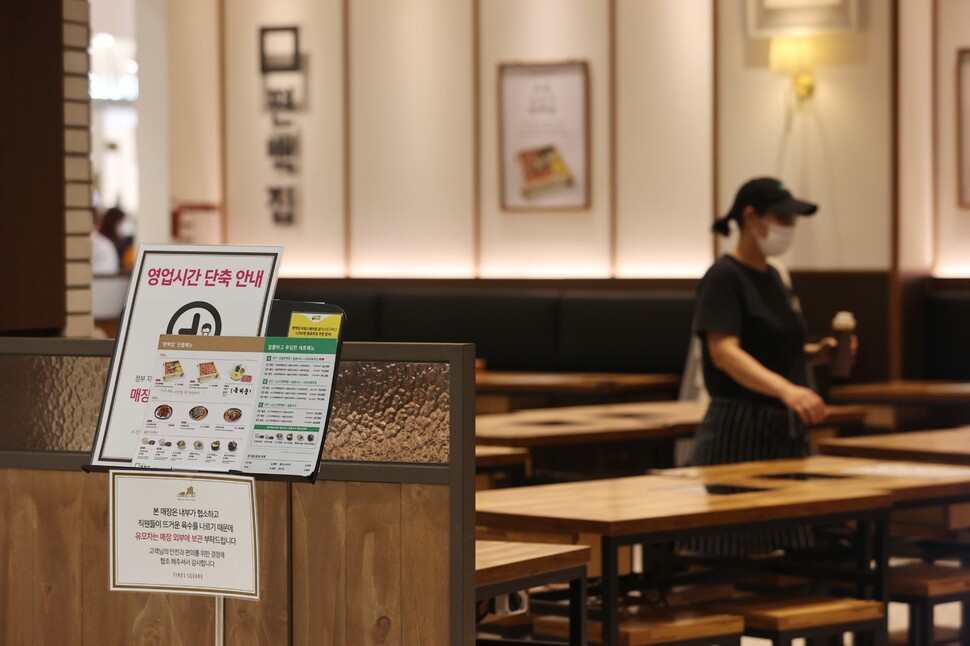
On the afternoon of the 6th, a restaurant located in a large shopping mall in Yeongdeungpo-gu, Seoul is showing a busy appearance on the afternoon of the 6th, when the government upgraded the social distancing stage in the metropolitan area from the previous stage 2.0 to stage 2.5 to respond to the re-proliferation of Corona 19. yunhap news
As the three local governments in Seoul, Gyeonggi, and Incheon issued an executive order banning’private gatherings for more than 5 people’ during the year-end and New Year holidays from 0 o’clock on the 23rd to the 3rd of the following month, 20 million citizens in the metropolitan area are planning Christmas and New Year holidays. Even change seems inevitable. Based on the data jointly announced by the local governments in the metropolitan area, the details of the administrative order and penalties for violations will be pointed out.
―Is it banned to eat out in a family of 5?
“All private gatherings with more than 5 people are prohibited, but people with the same residence on the resident registration card are allowed. Whether it’s at home or at an offsite facility, it’s both possible.”
―What if one Seoul citizen traveled to Jeju Island and gathered with four Jeju citizens?
“Because the administrative order is applied to citizens of the metropolitan area, no meetings of more than 5 people should be held in any area. It is also prohibited for non-metropolitan citizens to gather more than 5 people in the metropolitan area.”
―What is a’private meeting’?
“It’s all a group activity for fellowship. Alumni associations, clubs, outings, year-end parties, New Year’s parties, online cafes, workplace dinners, workshops, housewarming, as well as family gatherings such as first-birthday parties, sixtieth birthdays, and Chilsunyeon are also prohibited. It means not to gather except for the family living together. However, in the case of weddings and funerals, it is possible with less than 50 people (less than 30 people at the funeral hall in Seoul) at the level of 2.5 levels.”

Seoul Mayor Seo Jeong-hyup is speaking at a briefing in Seoul on the novel coronavirus infection (Corona 19) held at the Seoul City Hall on the 21st. Joint coverage photo.
―You are trying to gather more than 5 people for a customer meeting?
“If it is unavoidable due to the performance of public affairs by administrative and public institutions or management activities of companies, etc., it is not considered a private meeting. It does not matter if you work at a business site such as a company or factory, or gather at least five people at the National Assembly or government meetings. However, it is forbidden to eat more than 5 people with coworkers during lunch break.”
―Is it possible for 6 people to split into two tables of 3 people each?
“It is true that there is no way to crack down on six people coming together and splitting it into two tables, three at a time, while cheating on a restaurant owner. However, since the restaurant must adhere to the 2.5 steps of social distancing (△ 2m (minimum 1m) distance between tables △ one of the seats and one table spaced △ one of the partitions between the tables), even if the meeting was divided into two tables, conversations were not possible. It is likely to be difficult. Regardless of this executive order, meals at restaurants are not allowed after 9 pm, and cafes can only be packaged and delivered all day. While the Seoul Metropolitan Government is instructing not to accept more than 5 guests, it is also considering adding quarantine rules to secure the implementation of the ban on groups of 5 or more, such as reservation system for less than 4 people in advance or filling in the number of users.”
―Is the owner of the facility where the meeting was held also punished?
“According to the’Act on the Prevention and Management of Infectious Diseases’, a fine of not more than 3 million won is imposed on managers and operators of facilities where private meetings of 5 or more people are held. Those who participated in the meeting should also be fined 100,000 won. In addition, if a confirmed person comes out due to a violation of the administrative order, the right to reimburse medical expenses, etc. may be requested.” This executive order is to overcome the urgent situation so that a confirmed person who died while waiting at home comes out, but the evaluation of the effect is mixed. Kimo-ran, a professor at the National Cancer Center at International Cancer Graduate University (Department of Preventive Medicine), said, “It is a direct measure rather than closing (restaurants, etc.) stores, and since there are many social gatherings during the year-end and New Year, it is important in the sense of emphasizing the importance and necessity of social distancing. I think it’s a message.” It is an analysis that it is meaningful in that it is an order that regulates the behavior of citizens rather than regulates facilities. However, some point out that there is a fundamental limitation in that crackdown is difficult in that the banned target is’private gatherings’. Eom Joong-sik, a professor at Gachon University’s Gil Hospital (infectious medicine department), said, “Considering that it is difficult to monitor a meeting of five people, it seems to have a strong declarative meaning, and it is difficult to predict whether it will actually work. It seems that the central government has not upgraded to the third stage, so it seems to be a disincentive.” Kim Woo-joo, a professor at Korea University Medical School (infectious medicine department), said, “It may be partially affected, but it does not seem to be a measure that can alleviate the current shortage of hospital rooms.” Local governments also acknowledge that there are limitations. The Seoul Metropolitan Government said, “Because the purpose is to raise citizens’ awareness and participation, we are focusing on warning measures rather than crackdown.” I said. By Park Tae-woo, staff reporter [email protected]
